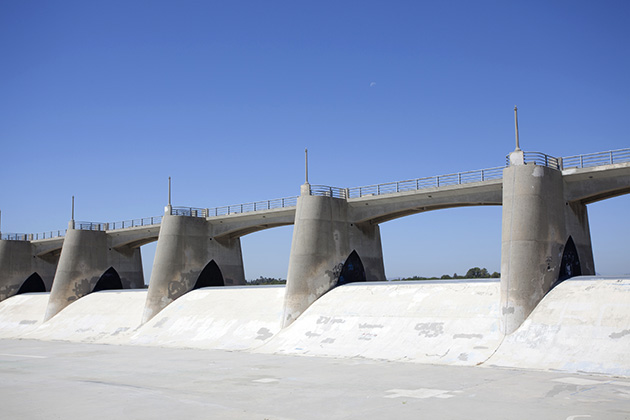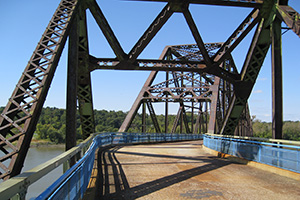Escape From New York | 1981


John Carpenter works wonders making a modest $5 million production look like a widescreen epic, using old school matte paintings, traditional animation and plenty of imagination.
It’s the distant future of ‘1997’ and the island of Manhattan is sealed off to become ‘New York Maximum Security Penitentiary’. When Air Force One is downed on the island, hardened criminal Snake Plissken (Kurt Russell) is offered a deal by Police Commissioner Hauk (Lee Van Cleef) if he’ll enter the lawless island and rescue the President (Donald Pleasence), who’s being held hostage.
Despite the setting, and the title, there’s very little of New York here. The filmed was made almost entirely in St Louis, Missouri, and around Los Angeles.
Most of the ‘Manhattan’ skylines are matte paintings, as in the opening scene of the raft of potential escapers being destroyed, which was filmed not in the East or the Hudson Rivers but just off the coast of Long Beach, California.
Apart from one misty morning shot of the Manhattan skyline seen towards the end of the film, the only glimpse of New York is the brief scene on Liberty Island, at the foot of the Statue of Liberty. Notice the smooth pan past the ‘Liberty Island Security Control Building’, which imperceptibly transitions to the ‘air control centre’, some two and a half thousand miles away.
The futuristic-looking concrete bridge is actually the Sepulveda Dam, 15758 Burbank Boulevard, Lake Balboa, in the San Fernando Valley north of Los Angeles.
Despite its modern appearance, the dam was completed in 1941 to hold back the waters of the Los Angeles River after the disastrous floods of 1938, which killed 144 people. A legacy of Sepulveda Dam is the flood control basin, a large, undeveloped area in the centre of the Valley, now used mostly as a wildlife refuge and recreation spot, as well as the channelisation of all the dry washes, which left the Valley with those hot, concrete-lined river bottoms instead of crystal streams. Although they’ve proved great for chase scenes.
You may recognise Sepulveda Dam from another futuristic fantasy. It’s famous from the final scene of cult classic, The Adventures Of Buckaroo Banzai Across The 8th Dimension, among other appearances.
As the manacled Plissken is taken for his briefing, the glum institutional corridors are those of the Art Center College of Design, 1700 Lida Street in LA’s eastern neighbour, Pasadena.
When Plissken reluctantly accepts the mission, the glider in which he’s sent to the island takes off from a tiny airstrip at Indian Dunes, near Valencia, California. With a good sense of the practicalities, the roof of the ‘World Trade Center’ was also recreated here so that the glider didn’t have to travel from the location. Incidentally, the ‘Chock Full O’Nuts’ store seen a little later on was also built at Indian Dunes.
The advantage of the Dunes’ airstrip (apart from being within a convenient distance of Hollywood) was the ability to film nighttime scenes without city lights showing in the background. This once popular 200-acre movie and television location, just north of Six Flags Magic Mountain, was closed in 1990 (the last scenes to be filmed here were for Joe Johnston’s The Rocketeer).
As Plissken makes his way down through the ‘Trade Center’ building, the graffiti-covered interiors are the upstairs rooms and corridors of the Wiltern Theatre, 3790 Wilshire Boulevard, midtown Los Angeles – but more of this venue later.
Everything changes once Plissken gets to the darkened streets of ’Manhattan’, and the location becomes St Louis, Missouri.
The darkened streets were filmed in downtown St Louis, an area which had been severely damaged during a massive urban fire in 1976. The city sportingly cooperated by turning off lights for several blocks during filming.
The plane crash site is the corner of North Broadway and St Charles Street, downtown St Louis – now unrecognisable after complete redevelopment. A decommission DC8 was bought from a wreckage yard in Tucson, Arizona, cut into three sections and quietly transported to St Louis (it seems that not all of the timewasting paperwork was completed), where the sections were dressed by production designer Joe Alves as a scene of urban devastation.
When Plissken follows the President’s tracking device to a rundown ‘Broadway’ theatre, you can make out the lettering on the frontage, where it announces that The Velvettes are performing ‘Olde Manhattan Melodies’, which reads Fox Theatre.
Indeed, this is the frontage of what is now the Fabulous Fox Theatre, 527 North Grand Boulevard. Rundown and derelict at the time of filming, the theatre has – like many of the locations used – been thoroughly renovated.
It’s a similar story for the theatre interior, where Plissken discovers Cabbie (Ernest Borgnine) happily singing along to a sad little revue (look out for director John Carpenter on violin in the pit orchestra). This is back to the auditorium Wiltern Theatre in Midtown LA. And that really is the shabby old basement of the Wiltern where Plissken discovers it’s an old derelict wearing the President’s security bracelet.
Whereas some productions (look at Pulp Fiction) seem to be filmed one step ahead of the wrecker’s ball, Escape From New York seems to have sparked a new lease of life for its rundown locations.
Like the Fabulous Fox, the Wiltern was in a sorry state of disrepair at the time of filming. It’s had its fair share of screen time – you can see it in the Chicago-set Streets Of Fire, Richie Valens biopic La Bamba and its lobby even became the front desk of Hollywood’s shabby ‘Hotel Earle’ for the Coen brothers’ Barton Fink.
The Wiltern, a green deco landmark towering over Wilshire Boulevard (see its exterior in Lethal Weapon) has also undergone a serious makeover and is now a prestigious musical venue.
Cabbie tells Plissken that the Pres is being held by Manhattan’s powerful overlord, the Duke Of New York.
It may be coincidental, but since the film has characters called Romero and Cronenberg there does seem to be a jokey name thing going on – the ‘Duke of New York’ was the name of the bar in Stanley Kubrick’s A Clockwork Orange.
Cabbie takes Plissken to see Brain (Harry Dean Stanton), who works for the Duke and who also turns out to be an old chum from Plissken’s past. The imposing classical façade of Brain’s domain, the, ‘New York Public Library’, is the New Masonic Temple, 3681 Lindell Boulevard in St Louis.
The 1926 building has its own bit of history – it houses the former officer of then-Senator (and Freemason Grand Master) Harry S Truman and, before flying solo to Paris aboard the Spirit of St Louis, aviator Charles Lindbergh was initiated as a mason at the temple. Coincidentally, Ernest Borgnine was a mason and had attended meetings here. In 2014, the masons moved out and the building was put up for sale.
The library interior, though, is back on the west coast, on the campus of the University of Southern California, south of downtown Los Angeles.
The lobby is the entrance to the Doheny Library, 3550 Trousdale Parkway (which you can also see in two Dustin Hoffman films – John Schlesinger’s 1976 thriller Marathon Man where, once again, it’s supposed to be in ‘New York’ and as ‘Berkeley’ in The Graduate), but the stacks, where a nodding donkey pumps away in the background, is the Hoose Library of Philosophy, 3709 Trousdale Parkway.
Outside on the streets of St Louis again, Plissken gets his first glimpse of the Duke (Isaac Hayes) in his magnificently chandelier-bedecked Cadillac.
Escaping the brick-hurling mobs on ‘Broadway’, Plissken and his cohorts arrive at the vast deserted railway sheds where the President is being held captive in a rail carriage. Another miraculous transformation job – St Louis Union Station, a then-vacant railway terminus, has since been renovated as a vast mall/hotel complex.
Opened in 1894, St Louis Union Station, 1820 Market Street, was once the world's largest and busiest train station. Those train sheds, which alone covered 11 ½ acres and boasted the largest roof span in the world, are now occupied by the retail and entertainment complex.
At first, Plissken seems to have rescued the Pres, but he’s soon captured by the Duke’s henchmen and obliged to prove himself in the ring against humongous wrestler Slag in front of baying crowds. This fight is staged in the station’s gold-leafed, barrel-vaulted and stained glass Grand Hall, which is now part of the DoubleTree Hotel.

Discovering that his glider has been unceremoniously dumped from the roof of the ‘World Trade Center’, Plissken needs to find another way off the island. The entrance to the WTC, where Cabbie turns up to save the day, is Century Plaza Towers, 2029 and 2049 Century Park East in Century City, once the old backlot of 20th Century Fox in west Los Angeles.
Along with Brain, Maggie (Adrienne Barbeau) and the President, he’s taken by Cabbie to the ‘69th Street Bridge’ which, though mined, is a connection to the mainland.

No, there’s no ‘69th Street Bridge’ in New York but even non-locals would have realized that the very real 59th Street Bridge carries more than two lanes of traffic. And, who knows, by 1997 a new bridge could have been built.
The ‘East River’ crossing is St Louis’ Chain of Rocks Bridge, spanning the Mississippi River on the north edge of St Louis to connect with Chouteau Island. One of the most famous Route 66 crossings of the Mississippi River, the bridge was closed for heavy traffic in 1970. But guess what? – over 40 years and $4 million later, it’s been renovated, graced with swanky new blue railings and opened to foot and cycle traffic.
Once over the bridge, the President is soon ready to address the nation on TV from the Sepulveda Dam site again – though that anarchic scamp Plissken has one trick left.





